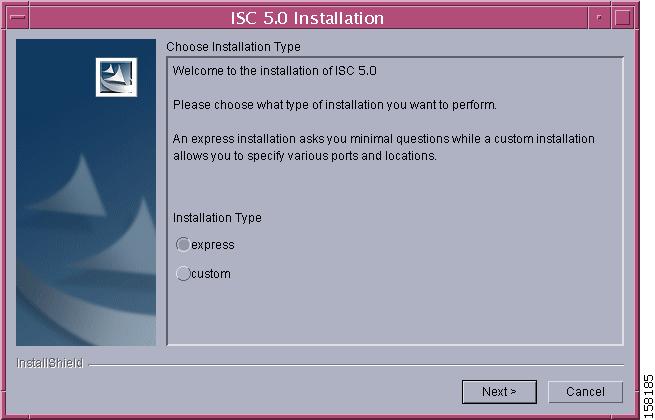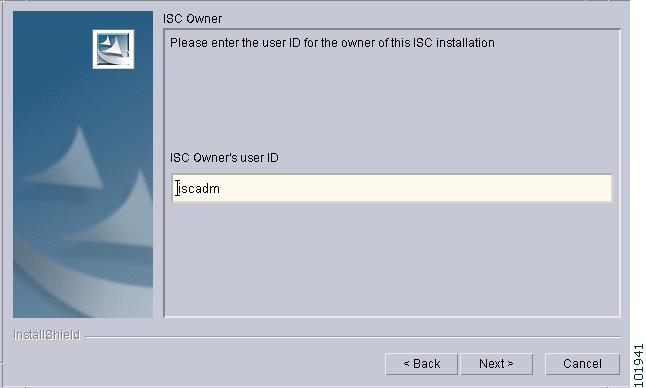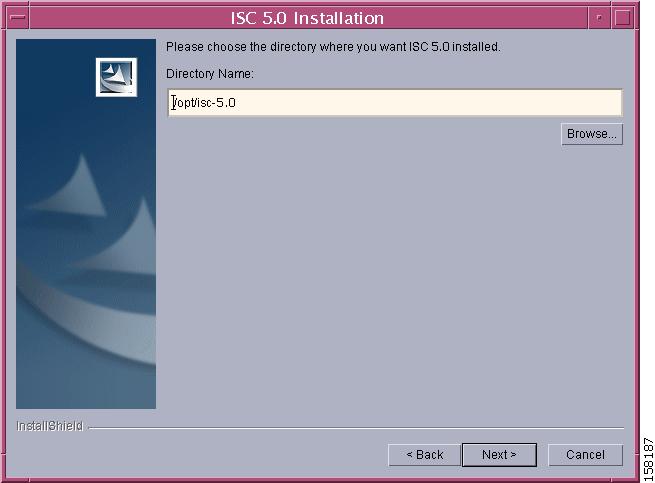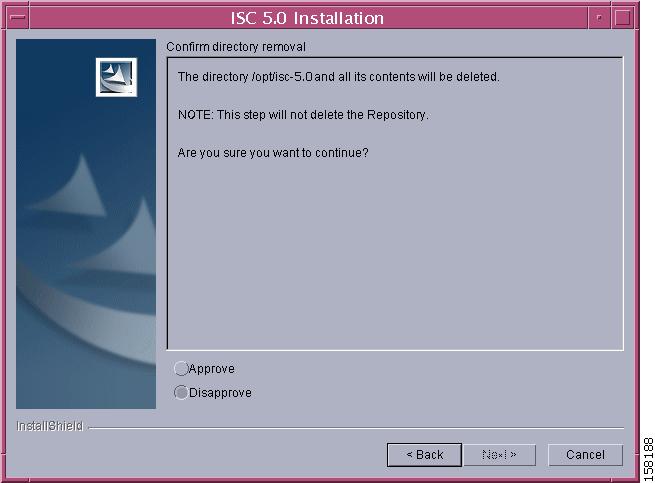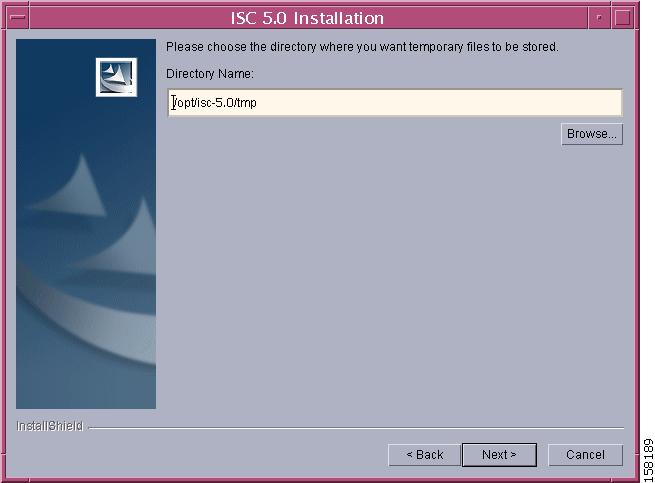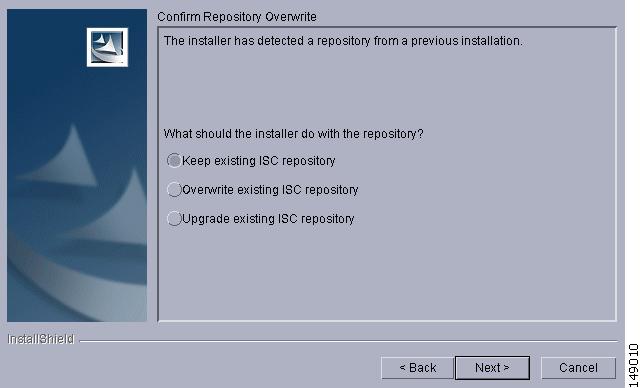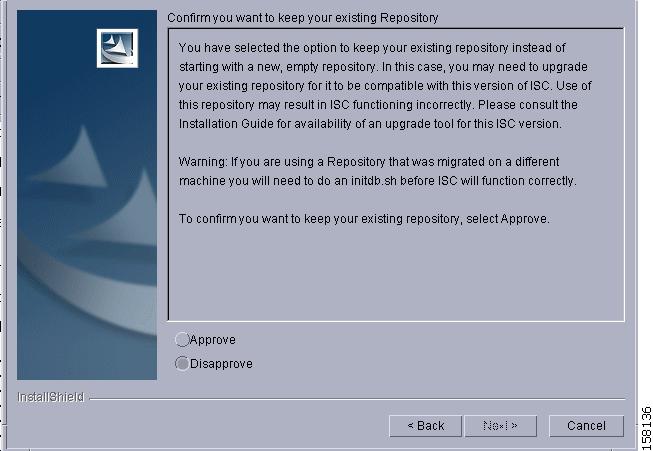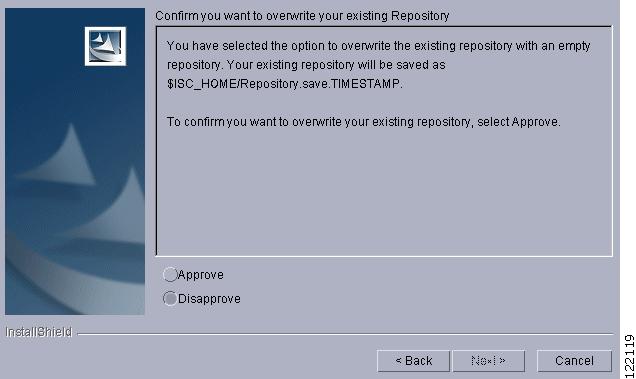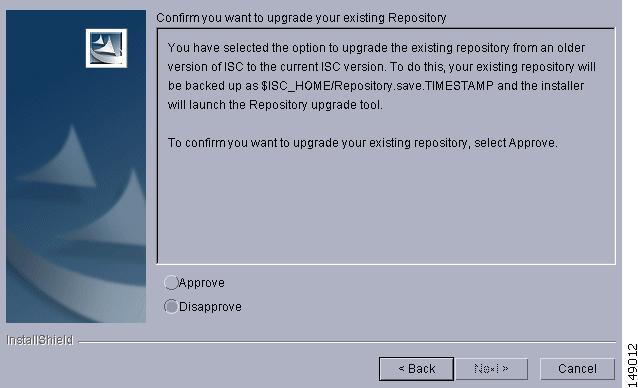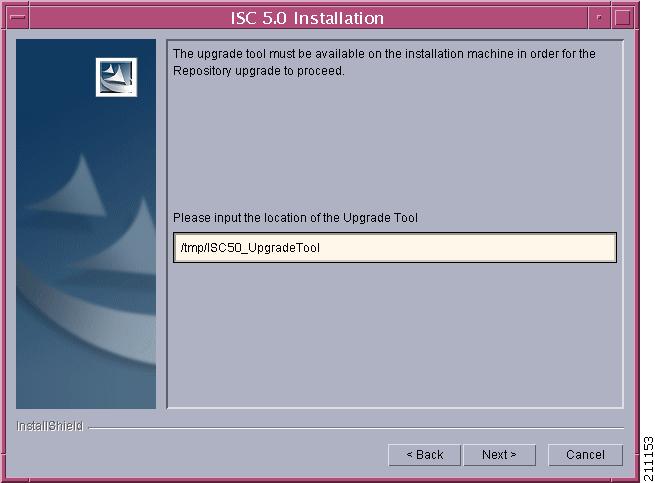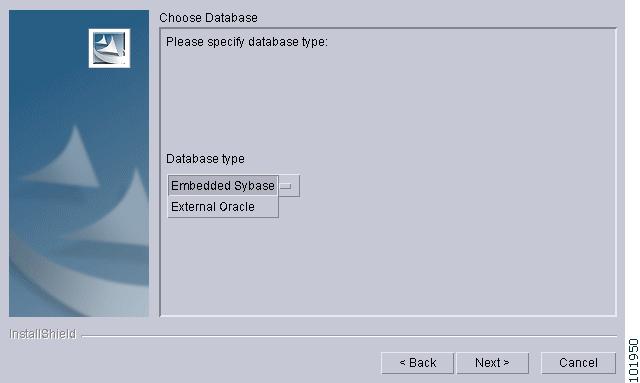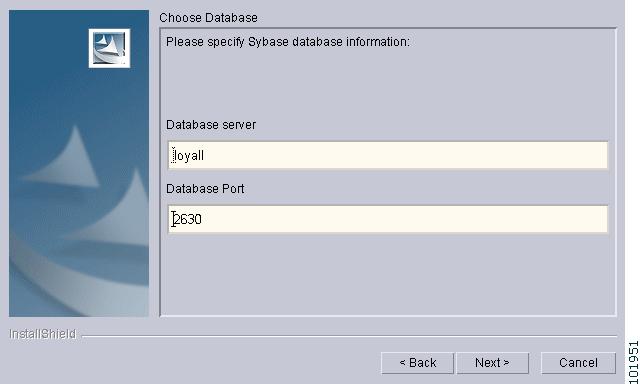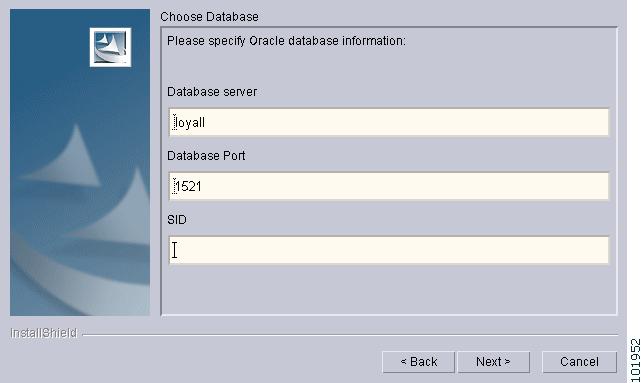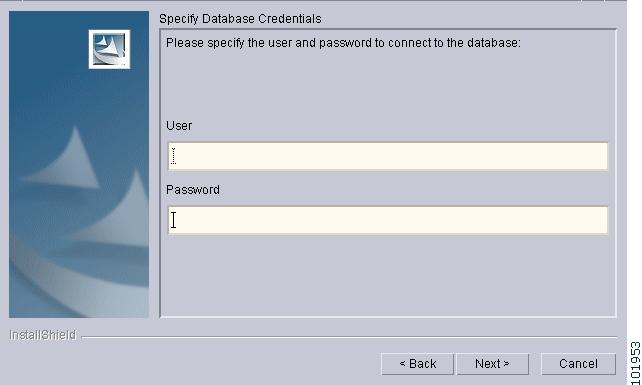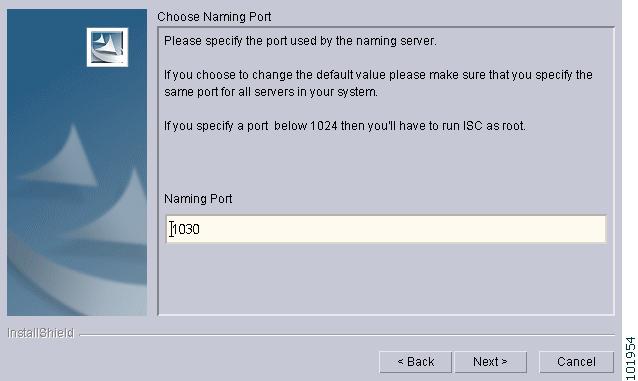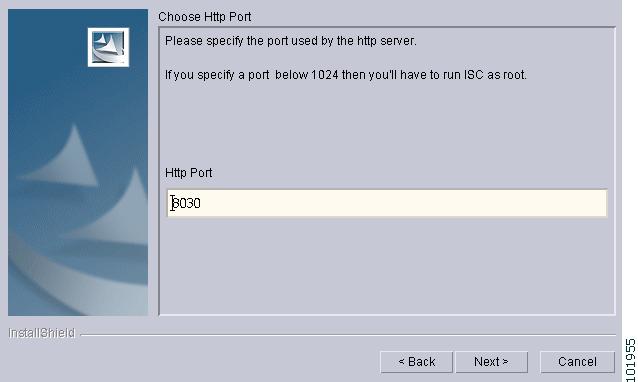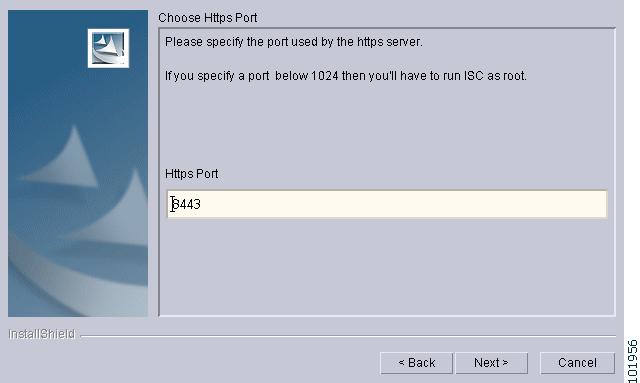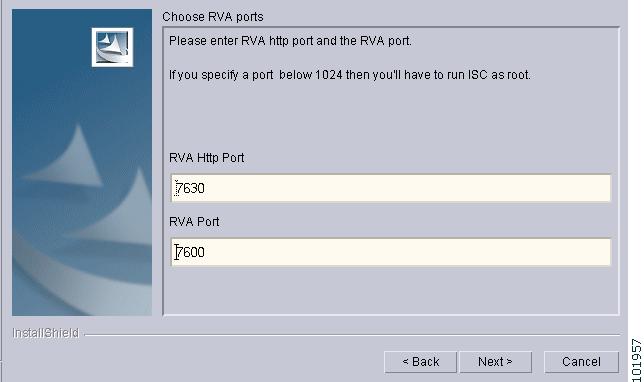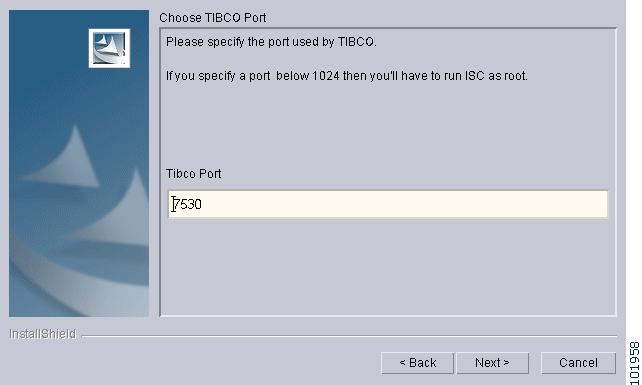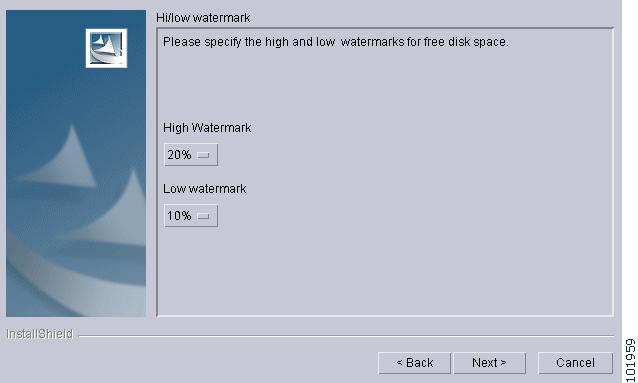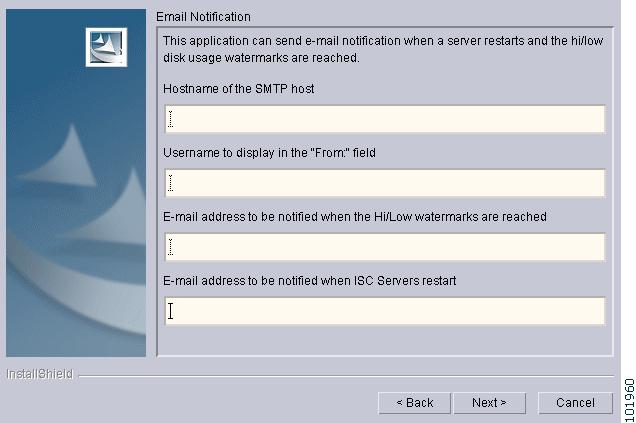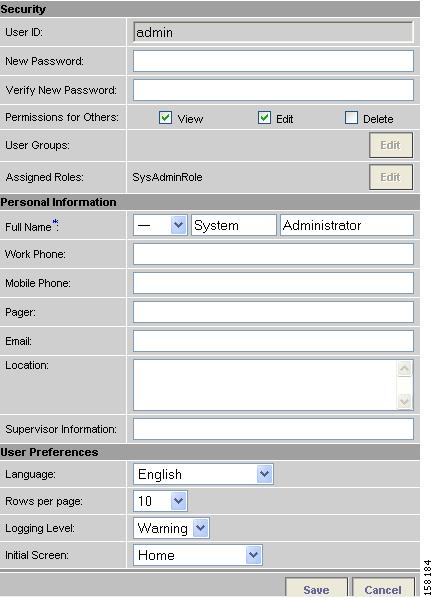

Table Of Contents
Installing and Logging In to ISC
Initial Configuration—Creating the ISC Owner
Installing ISC Using the Graphical User Interface
Installing ISC Using the Command Line Installer
Upgrading ISC Repositories to ISC 5.0
Upgrading ISC 3.2.2 or Later Repositories to ISC 5.0
Installing and Logging In to ISC
Use the information described in this chapter in the following order:
Note
See Chapter 1, "System Recommendations," before installing ISC.
•
Initial Configuration—Creating the ISC Owner
•
Installing ISC Using the Graphical User Interface
•
Installing ISC Using the Command Line Installer
•
Logging In for the First Time
•
Upgrading ISC Repositories to ISC 5.0
Packages Included with ISC
The ISC installer includes the following third party software:
•
ADCi® World Map Version 3.1
•
AdventNet® SNMP Version 4.0
•
Apache® Tomcat Version 5.5
•
ILOG® CPLEX Version 7.5
•
JCraft® JSch Version 0.1.30
•
Macrovision® FlexLM Version 7.2e
•
SourceForge® Ehcache Version 1.2.4
•
Sun Microsystems® Java JRE Version 1.4.2_08
•
Sybase® Adaptive Server Anywhere (ASA) Version 8.0.1
•
TIBCO® Rendezvous Version 7.1.15
Initial Configuration—Creating the ISC Owner
Note
If you are planning to use an Oracle database, understand that ISC 5.0 has been tested with Oracle Database 10g, Enterprise Edition Release 10.2.0.1.0 - 64 bit Production. If you would like to use another version of Oracle 10g, see Oracle's compatibility information. If you are upgrading ISC and were using a version of Oracle other than 10g, you must transfer your Repository to Oracle 10g. This can be done using Oracle import/export utilities or other methods. Proceed to Appendix A, "Setting Up Oracle for ISC" before continuing with the ISC installation. After you complete the Oracle set up, return here.
The first time you install ISC, create a UNIX user to own the software. This user is the default username when you log in to ISC. Create the user and group using Solaris commands or the Solaris Admintool. This user must have a valid group ID and read and write permissions to the install directory.
To add a user to your server using the standard Solaris commands, follow these steps:
Step 1
At the Solaris prompt, log in as root.
Step 2
To create the user, enter:
useradd -d /users/<username> -m -s /bin/<shell_type> <username>passwd <username>where:
-m creates the directory specified in -d
<shell_type> is sh for the Bourne Shell, ksh for the Korn Shell, or csh for the C Shell
iscadm is recommended as the <username>.
Step 3
At the prompt, enter a password.
Installing ISC Overview
To add ISC to your system, either as a new ISC customer or a customer upgrading from an existing ISC release, you can choose one of the following two ways to install:
•
Installing ISC Using the Graphical User Interface
•
Installing ISC Using the Command Line Installer
Note
It is not possible to install ISC for use with an Oracle database using the Command Line Installer. Therefore, if you will be using Oracle, be sure to use the GUI installation method, explained in the "Installing ISC Using the Graphical User Interface" section.
Cisco recommends you install ISC using the Graphical User Interface (GUI) installer. This option provides more configuration options.
The installer checks for two kinds of disk space:
•
In the intended install location, you need 1.2 GB free for the binaries plus an extra 250 MB for log file growth and the installation of the Cisco CNS Configuration Engine 1.3.x, 1.4, 1.5, or 2.0 software.
•
In the database directory, you need 1 GB free. For large systems, you should have 4 to 5 GB of space. If the directory has less than 1.2 GB free, you can still install ISC, but you might run out of space.
See Chapter 1, "System Recommendations" for more information about disk space and planning.
The complete installation for the ISC software requires 1.2 GB of free disk.
Installing ISC Using the Graphical User Interface
After reviewing the information in the "Installing ISC Overview" section, you can follow these steps to install the ISC software using the Graphical User Interface (GUI):
Note
If an existing ISC installation is running, enter the stopall command. See the Cisco IP Solution Center Infrastructure Reference, 5.0 for information about all WatchDog commands.
Step 1
Insert the ISC installation CD-ROM.
CautionWhen you insert the CD-ROM, the File Manager is invoked automatically. Do not use the File Manager to install the ISC product. Run the installation script from a terminal window.
Note
If you choose to remotely install over a wide area network, you must add two spaces at the end of each field for which you modify the entry. This is to work around a potential problem that occurs when you have two or more SSH tunnels between your location and your installation machine's location.
Step 2
Open a terminal window and log in as root.
Step 3
Change to the CD ROM directory:
$ cd /cdrom/cdrom0Step 4
If you have an existing ISC installation with a database, you must back up your current database. See the instructions to back up and restore an ISC repository or create a standby system, as explained in Appendix C, "Backup and Restore of ISC Repository and Standby System".
Step 5
Execute the ISC product installation script:
cdrom> ./install.shThe ISC software is installed by default in the /opt/isc-5.0 directory or a directory set up as follows.
If you are upgrading ISC from an existing version, make sure the existing ISC is shut down completely. Then do one of the following:
a.
Install ISC 5.0 in the same directory with the same directory name as the existing ISC product, as follows:
–
Save the ISC installation for possible uninstall purposes, as follows:
tar cvf <directory_name>.tar /opt/<directory_name>
–
Select this directory name in Step 8, Figure 2-3, "Specify Directory Location.
-or-
b.
Install ISC 5.0 in the same directory with a new name.
For example, if you are upgrading from ISC 4.2 to ISC 5.0 and the ISC installation is under the directory /opt/isc-4.2, then install ISC 5.0 in the same directory and rename it to /opt/isc-5.0, with steps like the following:
–
Save the ISC 4.2 installation for possible uninstall purposes, as follows:
tar cvf isc-4.2.tar /opt/isc-4.2
–
Rename the directory, as follows:
mv /opt/isc-4.2 /opt/isc-5.0
–
Select the directory /opt/isc-5.0 in Step 8, Figure 2-3, "Specify Directory Location."
-or-
c.
Install ISC 5.0 in a separate directory.
For example, if you are upgrading from ISC 4.2 to ISC 5.0and the ISC 4.2 installation is under the directory /opt/isc-4.2, then install ISC 5.0 in a new directory /opt/isc-5.0, with steps like the following.
–
Create the new ISC 5.0 directory, as follows:
mkdir /opt/isc-5.0
–
Copy the Repository from the ISC 4.2 directory to the new ISC 5.0 directory, as follows:
cp -r /opt/isc-4.2/Repository /opt/isc-5.0
–
Select the directory /opt/isc-5.0 in Step 8, Figure 2-3, "Specify Directory Location."
Step 6
In the next window, as shown in Figure 2-1, "Choose Installation Type," choose either the default express option or the custom option, then click Next.
When you click express, you have a minimal number of choices to make. When you click custom, you can specify various ports and locations and you can change the watermark level for available disk space.
Figure 2-1 Choose Installation Type
Step 7
In the next window, shown in Figure 2-2, "Choose ISC Owner," enter the username you created in Step 2 of the "Initial Configuration—Creating the ISC Owner" section.
Note
This field is only used when you are installing as root.
Figure 2-2 Choose ISC Owner
Note
If you enter an invalid name, you will receive a message indicating the name is invalid.
Step 8
Specify the location of the directory where you want to install, as shown in Figure 2-3, "Specify Directory Location," and then click Next. You can click Browse as an aid to finding an appropriate directory.
Note
If you are not installing as root, you must have write permission for this directory.
Note
In the intended install location, you need 1.2 GB free for the binaries plus an extra 250 MB for log file growth and the installation of the Cisco CNS Configuration Engine 1.3.x, 1.4, 1.5, or 2.0 software.
In the database directory, you need 1 GB free. For large systems, you should have 4 to 5 GB of space. If the directory has less than 1.2 GB free, you can still install ISC, but you might run out of space.Figure 2-3 Specify Directory Location
Step 9
If in Step 8 you chose a directory that already exists, you proceed as follows. If you chose a new directory to be created, you proceed to Step 10.
In Figure 2-4, "Confirm Directory Removal," if the directory you chose already exists and you must click the default radio button Disapprove, you cannot proceed. You must click Back and return to Step 8.
Be very careful. If you click the radio button Approve, you will overwrite the contents in the existing directory. Click Next.
Figure 2-4 Confirm Directory Removal
Step 10
If in Step 6 you chose express, proceed to Step 29. If you chose custom, then you must enter the location where you want temporary files stored, as shown in Figure 2-5, "Choosing the Directory for Temporary Files."
Note
In the intended install location, you need 1.2 GB free for the binaries plus an extra 250 MB for log file growth and the installation of the Cisco CNS Configuration Engine 1.3.x, 1.4, 1.5, or 2.0 software.
In the database directory, you need 1 GB free. For large systems, you should have 4 to 5 GB of space. If the directory has less than 1.2 GB free, you can still install ISC, but you might run out of space.Figure 2-5 Choosing the Directory for Temporary Files
Step 11
Specify the Directory Name where you want database files to be stored, as shown in Figure 2-6, "Where to Store Database Files," and then click Next.
Figure 2-6 Where to Store Database Files
Step 12
If in Step 11 you chose a directory that already contains a repository, you have three options, as shown in Figure 2-7, "Repository Choices,": Keep existing ISC repository, Overwrite existing ISC repository, or Upgrade existing ISC repository. Then click Next to proceed. Otherwise proceed to Step 13.
When you click Keep existing ISC repository, proceed to Step 13.
When you click Overwrite existing ISC repository, proceed to Step 14.
When you click Upgrade existing ISC repository, proceed to Step 15.
Figure 2-7 Repository Choices
Step 13
After choosing Keep existing ISC repository in Figure 2-7, "Repository Choices," you will be given the opportunity in Figure 2-8, "Confirmation of Keeping Existing ISC Repository," to Disapprove (the default). If you choose Approve, you will keep your existing ISC repository, which could be incompatible with this version of ISC.
Note
After you complete your installation and before you use ISC, to upgrade your down-level ISC 3.2 or later repository, you must follow the steps in the "Upgrading ISC Repositories to ISC 5.0" section.
Note
There is no direct way to upgrade from ISC 3.0 or ISC 3.1 to ISC 5.0. To upgrade from ISC 3.0 or ISC 3.1 to ISC 5.0, you must contact ISC Marketing, e-mail: isc-mktg@cisco.com.
Click Next and proceed to Step 18.
Figure 2-8 Confirmation of Keeping Existing ISC Repository
Step 14
After choosing Overwrite existing ISC repository in Figure 2-7, "Repository Choices," you will be given the opportunity in Figure 2-9, "Confirmation of Overwriting Existing ISC Repository," to Disapprove (the default). If you choose Approve, you will overwrite the existing repository with an empty repository and your existing repository will be saved as $ISC_HOME/Repository.save.<timestamp>.
Click Next and proceed to Step 18.
Figure 2-9 Confirmation of Overwriting Existing ISC Repository
Step 15
After choosing Upgrade existing ISC repository in Figure 2-7, "Repository Choices," you will be given the opportunity in Figure 2-10, "Confirmation of Upgrading Your ISC Repository After Installation," to Disapprove (the default). If you choose Approve, you will overwrite the existing repository with an empty repository and your existing repository will be saved as $ISC_HOME/Repository.save.<timestamp>. Then your installation will proceed with a new empty repository.
Click Next and proceed to Step 18.
Figure 2-10 Confirmation of Upgrading Your ISC Repository After Installation
Step 16
After you Approve to upgrade your existing Repository, enter the location of the Upgrade Tool, as shown in Figure 2-11, "Location of Upgrade Tool."
Figure 2-11 Location of Upgrade Tool
Step 17
If you inaccurately entered the location of the Upgrade Tool, you will receive a message as shown in Figure 2-12, "Invalid location of Upgrade Tool," and you must return to Step 16 and enter the correct Upgrade Tool location.
Figure 2-12 Invalid location of Upgrade Tool
Step 18
Choose the database you will use, as shown in Figure 2-13, "Choosing a Database". From the drop-down menu, choose either Embedded Sybase (Sybase ASA, 8.0.1 is embedded) or External Oracle. (Testing of ISC 5.0 has been done with Oracle Database 10g, Enterprise Edition Release 10.2.0.1.0 - 64 bit Production.) If you would like to use another version of Oracle 10g, see Oracle's compatibility information.) Then click Next.
Note
If you are upgrading from a version of ISC before ISC 5.0, make sure your ISC Repository has been imported to the Oracle Database 10g, Enterprise Edition Release 10.2.0.1.0 - 64 bit Production, as indicated in the "Initial Configuration—Creating the ISC Owner" section.
Note
The embedded Sybase database is used for service-level agreement (SLA), independent of whether you are using Oracle as your database.
Figure 2-13 Choosing a Database
Step 19
If you chose Embedded Sybase in Step 18, enter the Database server name, as shown in Figure 2-14, "Choosing a Database—Sybase." The Database Port number is automatically updated. If you choose to change the database port number, enter your choice in the Database Port field. Click Next, and then proceed directly to Step 22.
If you chose External Oracle in Step 13, proceed to Step 20.
Figure 2-14 Choosing a Database—Sybase
Step 20
If you chose External Oracle in Step 18, you must enter the Database server name, the Database Port number, and the Oracle server instance identifier (SID), as shown in Figure 2-15, "Choosing a Database—Oracle." Otherwise, proceed directly to Step 22.
Note
If you are upgrading from a version of ISC before ISC 5.0, make sure your ISC Repository has been imported to the Oracle Database 10g, Enterprise Edition Release 10.2.0.1.0 - 64 bit Production, as indicated in the "Initial Configuration—Creating the ISC Owner" section.
Figure 2-15 Choosing a Database—Oracle
Step 21
Because you chose External Oracle in Step 18, you must set the Oracle database User and Password values, as shown in Figure 2-16, "Specifying Database Credentials."
Figure 2-16 Specifying Database Credentials
Step 22
Specify the port used by the Naming Server, as shown in Figure 2-17, "Specify the Port Used by the Naming Server," then click Next.
Note
If you enter a Naming Port value less than 1024, the owner of the installation must be root. The owner of the installation is the user identified in Figure 2-2.
Figure 2-17 Specify the Port Used by the Naming Server
Step 23
Specify the port used by the HTTP server, as shown in Figure 2-18, "Choose HTTP Port," then click Next.
Note
If you enter an HTTP Port value less than 1024, the owner of the installation must be root. The owner of the installation is the user identified in Figure 2-2.
Figure 2-18 Choose HTTP Port
Step 24
Specify the port used by the HTTP Over Secure Socket Layer (SSL) (HTTPS) server, as shown in Figure 2-19, "Choose HTTPS Port," then click Next.
Note
If you enter an HTTPS Port value less than 1024, the owner of the installation must be root. The owner of the installation is the user identified in Figure 2-2.
Note
To configure the web access to ISC, you must set up the HTTPS port as explained in Step 35 and the "Installing ISC Using the Command Line Installer" section.
Figure 2-19 Choose HTTPS Port
Step 25
Specify the port used by the Rendezvous™ Agent (RVA). You must specify the RVA HTTP Port server, a TIBCO™ bus port used by ISC processes to communicate with each other. You must also specify the RVA Client Port, as shown in Figure 2-20, "Choose RVA Ports," then click Next.
Note
If you enter an RVA HTTP Port or RVA Client Port value less than 1024, the owner of the installation must be root. The owner of the installation is the user identified in Figure 2-2.
Figure 2-20 Choose RVA Ports
Step 26
Specify the port used by TIBCO, as shown in Figure 2-21, "Choose TIBCO Port," then click Next.
Note
If you enter a TIBCO Port value less than 1024, you must run ISC as root, the specification in Figure 2-2.
Figure 2-21 Choose TIBCO Port
Step 27
When you click Next, the system checks whether any of the ports entered are duplicate port numbers. If duplicate port numbers are found, an error message indicates the two ports that have duplicate entries.
Step 28
You can reset the High and Low watermarks for available disk space, as shown in Figure 2-22, "Setting Watermarks for Available Disk Space." The defaults are 20% and 10% for High and Low respectively. Be sure the High watermark is a larger percentage than the Low watermark. When the High and Low watermarks are reached, you receive an e-mail indicating this, based upon setting your e-mail address correctly in Step 29.
Figure 2-22 Setting Watermarks for Available Disk Space
Step 29
In Figure 2-23, "Setting E-mail Address for Receiving Watermark Information," to receive e-mail you must specify the following:
•
In the first text field, specify the hostname of the Simple Mail Transfer Protocol (SMTP).
•
In the second text field, specify the username to display in the "From" field.
•
In the third text field, specify the e-mail address to be notified when High and Low watermarks are reached, which indicates the specified disk space availability has been reached.
•
In the fourth text field, specify the e-mail address to be notified when the ISC server restarts.
Then click Next.
Figure 2-23 Setting E-mail Address for Receiving Watermark Information
Step 30
The installation continues and the files are installed. The list of installation processes appears.
Step 31
If the installation failed, you receive a failed message.
To review the log message, click Back.
If there was truncation of data, reinstall and add two spaces at the end of each field for which you have modified the entry.
Step 32
If the installation was successful, you receive an Install Complete message. Even if you have a successful install, click Back to review the log to be sure there were no exceptions or failures. If data was truncated, reinstall and add two spaces at the end of each field for which you have modified the entry.
Step 33
The ISC server is started automatically after the installation is successful.
Step 34
Verify that ISC is properly installed, as follows:
a.
Source the ISC environment file in the $ISC_HOME/bin directory:
If sh or ksh shell: . $ISC_HOME/bin/vpnenv.sh
If csh shell: source $ISC_HOME/bin/vpnenv.csh
b.
Before logging in, repeat the following command until the servers are in the started mode. If any server is reported as disabled, ISC is not installed or configured correctly:
wdclient status
For more information about WatchDog commands, see the Cisco IP Solution Center Infrastructure Reference, 5.0.
Step 35
If you want to set up secure web access by using HTTPS, see the "Installing ISC Using the Command Line Installer" section. Then, proceed to Step 36.
Step 36
If you are logging in for the first time, proceed to the "Logging In for the First Time" section." Then, proceed to Step 37.
Step 37
Before you can use any of the licensed services, proceed to the "Installing License Keys" section. Then, proceed to Step 38.
Step 38
If you have an ISC repository, you must upgrade your repository to have access to it, as explained in the "Upgrading ISC Repositories to ISC 5.0" section.
Note
There is no direct way to upgrade from ISC 3.0 or ISC 3.1 to ISC 5.0. To upgrade from ISC 3.0 or ISC 3.1 to ISC 5.0, you must contact ISC Marketing, e-mail: isc-mktg@cisco.com. Then, proceed to Step 39.
Step 39
If you want to eventually use the Inventory Manager or the Topology Tool, your client machine must be set up properly. Proceed to the "Launching Topology Tool" section. This section explains what occurs and leads you to the launching explanations in the Cisco IP Solution Center Infrastructure Reference, 5.0. Then, proceed to Step 40.
Step 40
To uninstall ISC, proceed to the "Uninstalling ISC" section.
Note
To determine if servers are installed correctly, use the WatchDog commands explained in the Cisco IP Solution Center Infrastructure Reference, 5.0.
Installing ISC Using the Command Line Installer
Note
It is not possible to install ISC for use with an Oracle database using the Command Line Installer. Therefore, if you will be using Oracle, be sure to use the GUI installation method, explained in the "Installing ISC Using the Graphical User Interface" section.
After reviewing the information in the "Installing ISC Overview" section, you can follow these steps to install the ISC software using the Command Line Installer:
Note
The command line installer only allows you to configure the installation directory and ISC owner. All other configuration options use default values. For more configuration options, use the GUI installer, explained in the "Installing ISC Using the Graphical User Interface" section.
Step 1
Insert the ISC product CD-ROM.
Note
When you insert the CD-ROM, the File Manager is automatically invoked. Do not use the File Manager to install the ISC product. Run the installation script from a terminal window.
Note
If you choose to remotely install over a wide area network, you must add two spaces at the end of each field for which you modify the entry. This is to work around a potential problem that occurs when you have two or more SSH tunnels between your location and your installation machine's location.
Step 2
Open a terminal window and log in as root.
Step 3
Change to the CD-ROM directory, as follows:
$ cd /cdrom/cdrom0
Step 4
If you are upgrading ISC from an existing version, use the stopall command to be sure the existing ISC is shut down completely. See the Cisco IP Solution Center Infrastructure Reference, 5.0 for information about all WatchDog commands.
Step 5
If you have an existing ISC installation with a database, you must back up your current database. See the instructions to back up and restore an ISC repository or create a standby system, as explained in Appendix C, "Backup and Restore of ISC Repository and Standby System."
CautionIf you use the command line installer to install ISC in a directory containing an existing installation of ISC, the installer replaces the existing repository with a new empty repository. You are not asked to confirm this operation and no alternative option is given. The directory containing the existing repository is renamed to Repository.save.<timestamp>.
Step 6
Execute the ISC product installation script, as follows:
cdrom> ./install.sh <target_dir> <owner>
where:
<target_dir> Specify the location of the directory where you want to install ISC. If you are upgrading an existing ISC installation, see the options in this step.
<owner> Enter the username you created in Step 2 of the "Initial Configuration—Creating the ISC Owner" section.
If you are upgrading an existing ISC installation, use one of the following options to specify the target directory:
a.
Install this version of ISC into the same directory as the existing ISC product.
For example, if you are upgrading from ISC 4.2 to ISC 5.0 and the existing ISC 4.2 installation is under the directory /opt/isc-4.2, then install ISC 5.0 in the same directory, with steps like the following:
–
Save the ISC installation for possible uninstall purposes, as follows:
tar cvf isc-4.2.tar /opt/isc-4.2
–
Execute the ISC product installation script, specifying the existing ISC directory name as the <target_dir>.
cdrom> ./install.sh /opt/isc-4.2 <owner>
-or-
b.
Rename the existing ISC directory before installing this new version of ISC into this directory.
For example, if you are upgrading from ISC 4.2 to ISC 5.0 and the existing ISC 4.2 installation is under the directory /opt/isc-4.2, rename this directory to /opt/isc-5.0 then install ISC 5.0 in the same directory, with steps like the following:
–
Save the ISC 4.2 installation for possible uninstall purposes, as follows:
tar cvf isc-4.2.tar /opt/isc-4.2
–
Rename the directory, as follows:
mv /opt/isc-4.2 /opt/isc-5.0
–
Execute the ISC installation script, specifying the renamed directory name as the <target_dir>.
cdrom> ./install.sh /opt/isc-5.0 <owner>
-or-
c.
Install ISC in a new directory.
For example, if you are upgrading from ISC 4.2 to ISC 5.0 and the existing ISC 4.2 installation is under the directory /opt/isc-4.2, then install ISC 5.0 in a new directory /opt/isc-5.0, with steps like the following:
–
Save the ISC 4.2 installation for possible uninstall purposes, as follows:
tar cvf isc-4.2.tar /opt/isc-4.2
–
Specify a new directory such as /opt/isc-5.0 as the <target_dir>
cdrom> ./install.sh /opt/isc-5.0 <owner>
Step 7
If you upgraded from an existing ISC installation and want to retain the database from that installation, manually copy the database directory to the new installation before running the upgrade tool.
a.
The directory in which you installed this release contains a directory named Repository that contains an empty repository. Temporarily rename this directory before copying the old repository. For example, you might wish to rename this directory to Repository.empty, as follows:
mv $ISC_HOME/Repository $ISC_HOME/Repository.empty
b.
If you installed ISC in a directory that contains an existing version of ISC by following either option a. or b. in Step 6, then the existing repository has been renamed to $ISC_HOME/Repository.save.<timestamp>. To restore the original database, enter the following:
mv $ISC_HOME/Repository.save.<timestamp> $ISC_HOME.Repository
c.
If you installed ISC in a new directory, as explained in option c. of Step 6, copy the Repository directory and its contents from the old ISC installation directory to the new ISC installation directory. For example, if you are upgrading from ISC 4.2 to ISC 5.0, where the old installation directory is /opt/isc-4.2 and the new installation directory is /opt/isc-5.0, enter the following:
cp -R /opt/isc-4.2/Repository /opt/isc-5.0/Repository
Step 8
If you have upgraded a previous ISC installation and want to retain the database from this installation, you must run the upgrade tool. Run the upgrade tool as explained in the "Upgrading ISC Repositories to ISC 5.0" section.
Configuring HTTPS
To configure the secure web access to ISC, set up the Hypertext Transfer Protocol (HTTP) Over Secure Socket Layer (SSL) (HTTPS) port, as follows:
Note
If you configure HTTPS, it does not disable HTTP. If you want to only allow HTTPS, then you need to block HTTP (default port: 8030) by a firewall.
Step 1
Source the environment file, as follows:
For K shell: . $ISC_HOME/bin/vpnenv.sh
For C shell: source $ISC_HOME/bin/vpnenv.csh
Step 2
Run the command: configSecurePort.sh <isc_home> <https_port> <hostname>
where:
<isc_home> is the home directory for ISC, for example: /opt/isc-5.0
<https_port> is the secure HTTPS port you want to use, for example: 8443.
<hostname> is the name of the machine that ISC is installed on, for example: machinename.cisco.com
Step 3
Copy the certificate server.cer from $ISC_HOME to all client ISC machines. Configure the browser on your client to store this certificate as trusted. For information on how to do this, see your browser documentation.
Note
If you specify an IP address instead of a hostname, you must then use this IP address for all HTTPS sessions. If you attempt to use the hostname after configuring with an IP address, you will receive hostname mismatch warnings and might see unexpected behavior while using ISC.
Note
If you do not implement Step 3 correctly, your browser might warn you that it is unable to verify or trust the security of the ISC server. Always accept ISC's digital certificates when prompted. Additional security precautions might be generated by your browser but should not affect the performance of ISC.
Logging In for the First Time
To log in to ISC for the first time, follow these steps:
Step 1
In your browser, enter the following URL:
http://server:port/isc/
Note
If you are using secure HTTPS access, as explained in the "Installing ISC Using the Command Line Installer" section, enter https://server:port/isc/ instead.
See the "Installing ISC Overview" section for information about setting the port number.
Step 2
Enter the default administrative login name, admin, and password, cisco, then click Login.
This default user provides administrative access to ISC. You cannot delete this user.
Step 3
We highly recommend you change the password for admin from cisco to something secure for you. To do this, click the Administration tab, then click Security, then click Users. Select the admin check box and then click Edit.
The window, as shown in Figure 2-24, "Changing the Password for Security Reasons" appears.
Step 4
Enter the Security and Personal Information, then click Save.
Figure 2-24 Changing the Password for Security Reasons
Installing License Keys
To install license keys, do the following:
Note
For detailed instructions, see the Licensing section in the Cisco IP Solution Center Infrastructure Reference, 5.0.
Step 1
From the Home page of the installed ISC product, navigate as follows: Administration > Control Center > from the TOC, click Licensing.
Step 2
From the Installed Licenses table, click Install.
Step 3
In the resulting window, enter a License Key that you received on your Right to Use paperwork with your product.
Step 4
Click Save. Your newly installed license appears in an updated version of the Installed Licenses table.
Step 5
Repeat Step 2, Step 3, and Step 4 for each of the Right to Use documents shipped with your product.
Upgrading ISC Repositories to ISC 5.0
If you have an existing ISC repository, you must upgrade it to be able to use it with ISC 5.0, as follows:
Note
Understand that the only Sybase version to which you can upgrade is the embedded Sybase ASA, 8.0.1. Also, understand that Oracle testing of ISC 5.0 has been done with Oracle Database 10g, Enterprise Edition Release 10.2.0.1.0 - 64 bit Production. If you would like to use another version of Oracle 10g, see Oracle's compatibility information.
•
If you have an existing ISC 3.0 or 3.1 repository, you must contact isc-mktg@cisco.com for upgrade instructions.
Note
There is no direct way to upgrade from ISC 3.0 or ISC 3.1 to ISC 5.0. To upgrade from ISC 3.0 or ISC 3.1 to ISC 5.0, you must contact ISC Marketing, e-mail: isc-mktg@cisco.com. Then, proceed to Step 39.
•
If you have an existing ISC 3.2.0.x repository, you must upgrade to ISC 3.2.2 before using the instructions in the "Upgrading ISC 3.2.2 or Later Repositories to ISC 5.0" section. To upgrade to ISC 3.2.2, you must choose the appropriate upgrade script for your Sybase or Oracle Repository and follow the instructions located at http://www.cisco.com/pcgi-bin/tablebuild.pl/isc.
•
If you have an existing ISC 3.2.2 or later repository, you must upgrade it to be able to use it with ISC 5.0, as explained in the "Upgrading ISC 3.2.2 or Later Repositories to ISC 5.0" section.
Upgrading ISC 3.2.2 or Later Repositories to ISC 5.0
If you have an ISC 3.2.2 or later Repository, you use the same upgrade procedure steps independent of whether your repository is a Sybase or Oracle repository.
Note
Before you upgrade your Repository, you must have followed the steps in the "Installing ISC Overview" section. You must have backed up your database, as explained in Step 4, and you must have followed all the steps and reached this section from Step 38. A Repository can be upgraded only once. If there is any problem during upgrade, a new copy of the backed up Repository is needed for subsequent upgrade attempts.
Note
See Appendix C, "Backup and Restore of ISC Repository and Standby System," before upgrading your repository.
Upgrade your ISC 3.2.2 or later repository as follows:
Step 1
Get the upgrade package ISC50_UpgradeTool.tar.gz from http://www.cisco.com/pcgi-bin/tablebuild.pl/isc and place it on the ISC Master machine in a directory where you can access the ISC environment.
Step 2
Untar the upgrade tool tar file.
gzip -d < ISC50_UpgradeTool.tar.gz | tar xvf -
Step 3
Source the ISC environment files.
If sh or ksh shell: . $ISC_HOME/bin/vpnenv.sh
If csh shell: source $ISC_HOME/bin/vpnenv.csh
Step 4
Stop ISC.
stopall
Step 5
Run the upgrade script.
cd ISC50_UpgradeTool
./upgradeISCSchema.sh <ISC home>
where: <ISC home> is the full pathname of the ISC home directory.
Step 6
Check for a success or error message.
Note
After upgrading between ISC versions, you should ensure that the cache of the ISC client browser has been cleared or that your browser does not use the cache. This will ensure the latest ISC images and pages are returned.
Launching Topology Tool
ISC provides a downloadable version of Version 1.4.2_04 of Java Runtime Environment (JRE) for various operating systems when you launch Topology Tool. If you choose to install JRE Version 1.4.2_04, you must quit the browser, uninstall the existing JRE version, install the new 1.4.2_04 version, and log in again.
Specific instructions to launch the Topology Tool are explained in the Cisco IP Solution Center Infrastructure Reference, 5.0.
Uninstalling ISC
To uninstall the server, as follows:
Step 1
Log in to the server.
Step 2
At the Solaris prompt, log in as the ISC owner.
Step 3
Go to the ISC installation directory.
Step 4
Source the environment, as follows:
For a sh or ksh shell:
. bin/vpnenv.shFor a csh shell:
source bin/vpnenv.cshStep 5
Remove ISC by entering the following command from a location outside the <ISC_HOME directory>:
uninstall.shThis command removes all files from the installation directory. This command also removes the database and its contents. Database backups are not removed if they reside in a different directory from the installation directory.

 Feedback
Feedback

